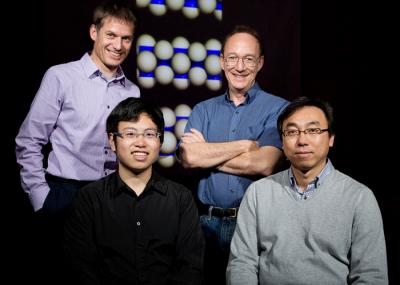Nov 22 2012
With self-assembly guiding the steps and synchronization providing the rhythm, a new class of materials forms dynamic, moving structures in an intricate dance.
 Researchers from the University of Illinois and Northwestern University demonstrated tiny spheres that synchronize their movements as they self-assemble into a spinning microtube. Back, L-R: Northwestern University professor Erik Luijten, U. of I. professor Steve Granick. Front: Grad student Jing Yan, research scientist Sung Chul Bae. Credit: L. Brian Stauffer
Researchers from the University of Illinois and Northwestern University demonstrated tiny spheres that synchronize their movements as they self-assemble into a spinning microtube. Back, L-R: Northwestern University professor Erik Luijten, U. of I. professor Steve Granick. Front: Grad student Jing Yan, research scientist Sung Chul Bae. Credit: L. Brian Stauffer
Researchers from the University of Illinois and Northwestern University have demonstrated tiny spheres that synchronize their movements as they self-assemble into a spinning microtube. Such in-motion structures, a blending of mathematics and materials science, could open a new class of technologies with applications in medicine, chemistry and engineering. The results will be published in the Nov. 22 edition of the journal Nature.
"The world's concept of self-assembly has been to think of static structures – something you would see in a still image," said Steve Granick, Founder Professor of Engineering at the U. of I. and a co-leader of the study. "We want shape-shifting structures. Structures where a photograph doesn't tell you what matters. It's like the difference between a photograph and a movie."
The researchers used tiny particles called Janus spheres, named after the Roman god with two faces, which Granick's group developed and previously demonstrated for self-assembly of static structures. In this study, one half of each sphere is coated with a magnetic metal. When dispersed in solution and exposed to a rotating magnetic field, each sphere spins in a gyroscopic motion. They spin at the same frequency but all face a different direction, like a group of dancers in a ballroom dancing to the same beat but performing their own steps.
As two particles approach one another, they synchronize their motions and begin spinning around a shared center, facing opposite directions, similar to the way a couple dancing together falls in step looking at one another.
"They are both magnetized, which causes them to attract each other, but because they're moving, they have to move in sync," said Erik Luijten, a professor of materials science and engineering and of applied mathematics at Northwestern University who co-led the research with Granick.
Soon, the pairs and clusters of dancing spheres assemble themselves into a microtube – a long, hollow structure. The entire tube spins, even as each individual sphere continues its motion as well, like dancers in a line dance completing their individual steps as the line moves.
"It's spontaneous. We don't force it to form," said U. of I. graduate student Jing Yan, the first author of the paper. "We saw that during the self-assembly process, the synchronization also happens. If you look at the spheres, every one is doing a different thing. Only when they come in close contact will they do something cooperatively. The two concepts are intricately related in this system."
Now that the researchers have detailed the delicate choreography of synchronization and self-assembly, they hope to explore applications for this new class of moving structures. One potential application of a dynamic, self-assembled microtube is to transport and release cargo. A particle or collection of molecules could be encapsulated in the tube and transported to a different location. Then, the tube can be disintegrated, releasing the cargo at a target point.
"We're looking for the new applications that people haven't dreamt up yet because they didn't have the capability," said Granick, a professor of materials science and engineering.
Next, the researchers are working to further understand the properties governing synchronized self-assembly and ways to guide it for functionality, such as manipulating the structures with an electrical or magnetic field. They also plan to explore directing the Janus spheres to synchronized self-assembly of other shapes and structures, allowing even more applications.
"Traditionally in self-assembly, you make a specific building block that will organize into a specific structure," Luijten said. "If you want a different structure you have to make a different building block. Here now, with one building block, we can control the structure by exploiting the synchronization effect."